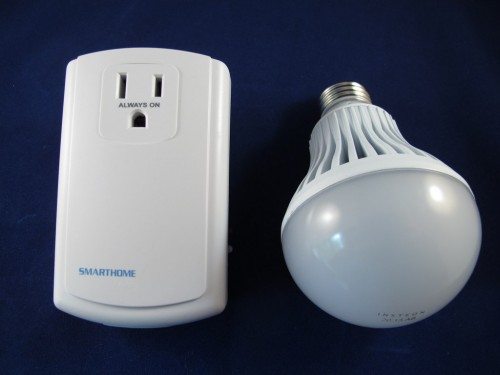 I’ve been using X10 products to remotely and automatically control some of the lights and appliances in my house for years. Insteon is the next generation of X10-compatible devices sold by SmartHome. I’ve been considering updating the devices in my house to take advantage of the new technology, so I thought I’d start with something simple like a network controllable light bulb. Should be easy — right? We’ll see.
I’ve been using X10 products to remotely and automatically control some of the lights and appliances in my house for years. Insteon is the next generation of X10-compatible devices sold by SmartHome. I’ve been considering updating the devices in my house to take advantage of the new technology, so I thought I’d start with something simple like a network controllable light bulb. Should be easy — right? We’ll see.
The bulb can be used standalone, but that doesn’t make use of the features:
- World’s first networked dimmable light bulb
- Energy-saving, 8W LED bulb shines as brightly as a 60W incandescent bulb
- Software configurable: link to additional controllers, add to scenes and customize ramp rates and brightness levels
- Up to 52,000 hour life
- Featuring dual-band INSTEON technology for the fastest and most reliable performance
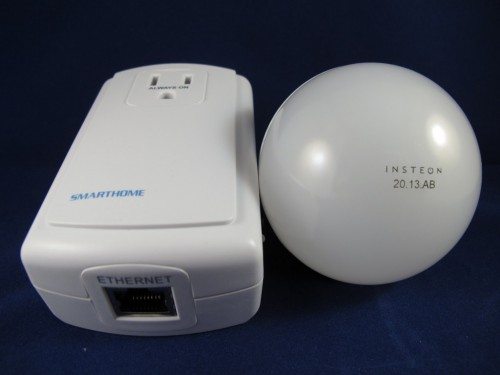 Along with the bulb, I received a Smartlinc Hub. It’s a controller that you plug into any AC outlet in your home and then attach an Ethernet cable to your modem or router. The AC outlet on the device is a pass thru.
Along with the bulb, I received a Smartlinc Hub. It’s a controller that you plug into any AC outlet in your home and then attach an Ethernet cable to your modem or router. The AC outlet on the device is a pass thru.
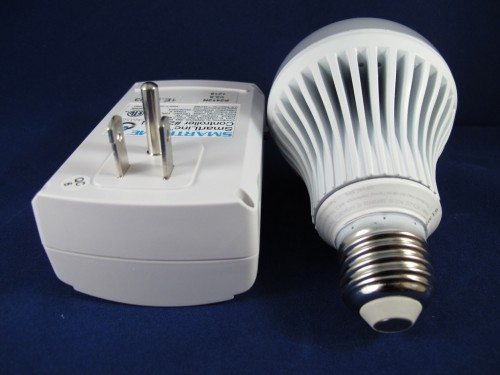 A look at the backside of the hub and a bottom view of the bulb. You’ll notice the bulb has a standard screw base and fits in most light sockets.
A look at the backside of the hub and a bottom view of the bulb. You’ll notice the bulb has a standard screw base and fits in most light sockets.
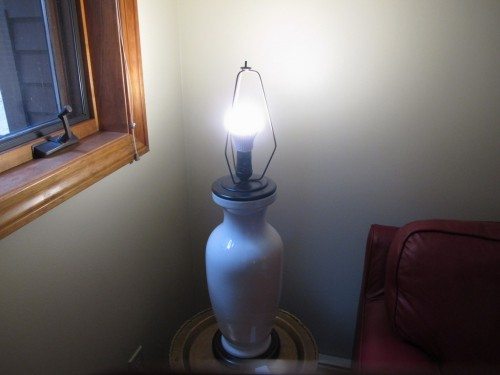 I plugged the bulb into a table lamp and turned it on. This could have been the end of this review, because the light turned on and seemed to illuminate as much as a 60 watt incandescent bulb. However, it would be much more fun to be able to turn the lamp on and off remotely, whether at home or on the road!
I plugged the bulb into a table lamp and turned it on. This could have been the end of this review, because the light turned on and seemed to illuminate as much as a 60 watt incandescent bulb. However, it would be much more fun to be able to turn the lamp on and off remotely, whether at home or on the road!
This first step to automation is to plug-in the Smartlinc box into an AC outlet. Then I plugged an Ethernet cable between the box and my router. From this point on, you fire up the app (either iOS or Andriod) on your WiFi device and follow the instructions to add the bulb to your list of controlled devices. Although my configuration only contained an LED bulb, there are other INSTEON devices that can control appliances, regular lamps and most anything electrical. Check their website for products.
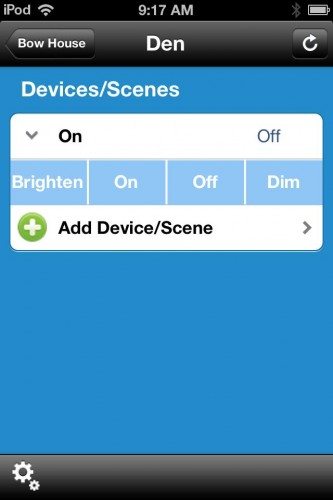 Once you’ve added the device, in this case the LED bulb, you can add functions to turn the device on/off and set timers. The above screen shot is from my iPod. There is also an app for Android devices.
Once you’ve added the device, in this case the LED bulb, you can add functions to turn the device on/off and set timers. The above screen shot is from my iPod. There is also an app for Android devices.
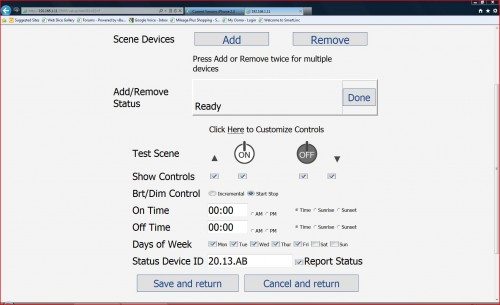 You can setup times and controls for devices.
You can setup times and controls for devices.
My hope when getting the INSTEON controller was that it would overcome the problem I was having with my X10 devices. X10 and unfortunately INSTEON communicate via the power lines, superimposing a signal on the AC. A problem arises when you have a controller on one line of the two coming in from the street and a device on the other side of the transformer. The signals to do not couple between the two. I’ve tackled this issue by only connecting controlled devices to one side of the circuit breaker panel, which means I can use X10 or INSTEON only in certain rooms.
INSTEON is billed as a dual -band device, meaning that it transmits its signal via the power line and RF. This is true only for dual-band devices, and the Smartlinc is not one of them. So, to make the LED bulb remotely controllable in my den, I had to run an extension cord from an outlet in a spare bedroom to my home office, which was on the same leg of the incoming line as the bulb. I plugged the Smartlinc in and all was well. This shortcoming can be fixed by purchasing a phase coupler and having an electrician install it in the breaker panel. I’m just too cheap to pay the $100+ this would cost.
From reading the INSTEON web site, I understand that the INSTEON network becomes more robust and reliable as you add devices, because it uses a mesh network and all control signals are repeated by every device on the net, insuring the commands get sent and acknowledged.
Now that I had the bulb talking to the Smartlinc, I can turn the light on/off and dim it from my iPod and Android Smart phone. This can be done from in the house or on the road, because during setup, the app opened a port on my router using UPnP. I can turn on the lamp in the den before I get home, so I can see when I step into the house, and I have the light on a timer to turn on and off at certain times.
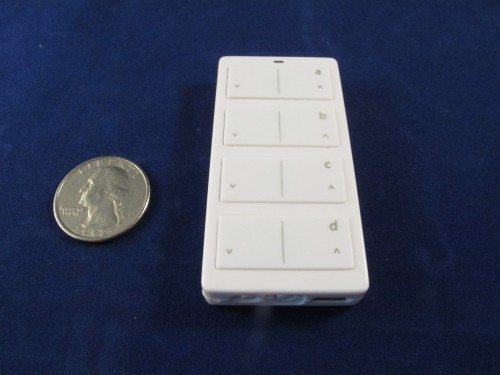 I also received a mini remote with the evaluation package. This device sends an RF signal and was easily linked to the LED bulb, which is a dual-band device. However, the mini remote is useless. It has a range of no more than 2 feet from the bulb. I’m sure it would perform much better if there were other dual band INSTEON devices in my network, because any one of them receiving the mini remote signal would re-transmit it via power line to the bulb.
I also received a mini remote with the evaluation package. This device sends an RF signal and was easily linked to the LED bulb, which is a dual-band device. However, the mini remote is useless. It has a range of no more than 2 feet from the bulb. I’m sure it would perform much better if there were other dual band INSTEON devices in my network, because any one of them receiving the mini remote signal would re-transmit it via power line to the bulb.
I have a confession to make. I like playing with these home automation devices, but a reality check is in order. The cost of controlling one LED bulb in my house comes to almost $130. That’s $29.99 for the bulb and $99 for the Smartlinc controller; and if you consider the mini-remote, that’s another $44.99. I’ve read stories wondering why home automation hasn’t caught on. Maybe it’s because the prices are too high.

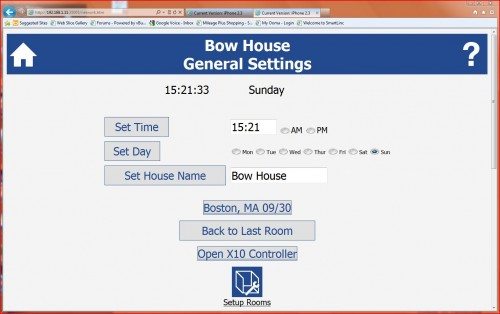


Gadgeteer Comment Policy - Please read before commenting
smarthome has a device – forgotten the name – that plugs into your drier outlet and solves the two phase problem you mention. Still costs $100 but if you are lazy like me it is a very easy fix.
I’ve dreamed of home automation for many years. I used cheap ($10-15) X10 devices in my old house and struggled because they weren’t reliable. Then I got married and my wife and I built our dream house. I believed the Insteon devices must be better than the cheap X10 because they use more advanced technology. Besides, they cost 4-6 times more so they must be good – right? I foolishly talked my wife into investing in Insteon switches all over our new home. We bought a mixture of the 2786D, 2876D, 2476D, 2876S devices. In total we purchased more then 55 Insteon switches directly from SmartHome at a cost of well over $2000. Within the first 3 years nearly half of them had failed. My wife started leaving flashlights scattered around the house so she could see in dark rooms. You can imagine the fun *conversations* SmartHome added to our newly married life. The 1st day she put makeup on my flashlight was not a good day. Smarthome told me they had a bad shipment of the tiny PC board mount switches that are components of the device. I was lucky enough to get stuck with a lot of them. They offered to let me buy new ones and they would refund my money when I shipped the bad ones back! Of course it was my responsibility to pay for an electrician to come replace half the switches in my home. I asked for a credit for additional products and was told no. When I pressed them on this the SmartHome rep told me they were extending the warranty to 5 years on my new switches and that’s all they could afford to do. How nice of them – more on that in a moment… I ordered the switches and had them replaced.
In March of 2012 I contacted SmartHome again because by then another 21 switches had failed. They have changed their ordering system so my original orders no longer appear when I log in to the website. I have no way to prove anything about what I ordered when, other than what SmartHome tells me. Of course I have a big box of newly defective switches I can point to as proof, but… The next thing they told me was there is no 5 year warranty extension for the recently replaced switches. Of course the previous salesperson told me that over the phone so – no proof. My mistake for trusting something a mfg phone rep told me. SmartHome did offer to replace any failed switches that fall under their “paddle issue extension”, but only once I went around and pulled the cover on each switch to give them the revision number. Then they would tell me how many they would warranty. Of course I am welcome to just buy new ones to replace all the rest of the defective switches. I know many of my currently failed devices are not due to the “paddle issue” because some are keypad switches, some continuously blink on and off, some don’t light the LED indicator at all (dead) and one actually smoked! I seems to me the manufacturer of an electrical device that arced internally would want that back so they could examine it. I emailed with a SmartHome “External Manager” and pressed her pretty hard to do the right thing. She simply would not budge. I would post the email thread here, but she included a “CONFIDENTIALITY NOTICE” in her email replies so I assume I would be sued by SmartHome if I shared her responses to my requests, which SmartHome considers to be “confidential and privileged”.
I am a big technology advocate and would love for our home to be a showcase of what is possible with SmartHome products. Instead it is an embarrassment when guests come over and I have to explain why switches in various rooms don’t work. I gave SmartHome every opportunity to do the right thing. Personally I believe they *can’t afford to do the right thing* because apparently their product is not built to last. You can’t make a profit if you sell something that will fail then offer to fix it for free.
I’ve literally spent thousands of dollars and still have switches failing even today. We wired our home and planned our switch placement based on this technology working. For example we have a bank of 8 switches that control all our living room and deck lights. We wired these to boxes around the corner in a hallway and mounted a Keypadlinc at the entrance of the room. The idea was to press a keypad button to call up a light scene and not have 8 switches visible in the room. We never were able to get that working properly and the Keypadlinc switch in that position has failed twice. I’m not real excited about buying a 3rd one. Right now we walk through the dark room to the hallway and manually press the switches we need to light the living room. Bottom line, I wish I had never heard of Insteon. I could have bought $100 worth of manual switches and avoided all these headaches. Fortunately my wife doesn’t blame me. We blame SmartHome.
I have over 50 Insteon switches in my home and for the last 9 years or so, not even 1 failed on me. I even have one Insteon switch mounted outside, but inside a metal box, for my landscape lightings and in the FL Summer months, it gets very hot and it still working perfectly for 9 years and still going strong.
Love Insteon.
I am embarking on a ha project and considering Insteon. Roberts post gives me pause. Is there any way to know if these issues are behind them? Maybe the dual band generation is anew era?